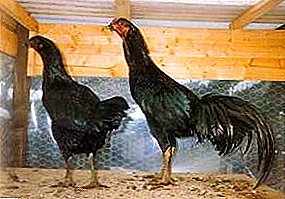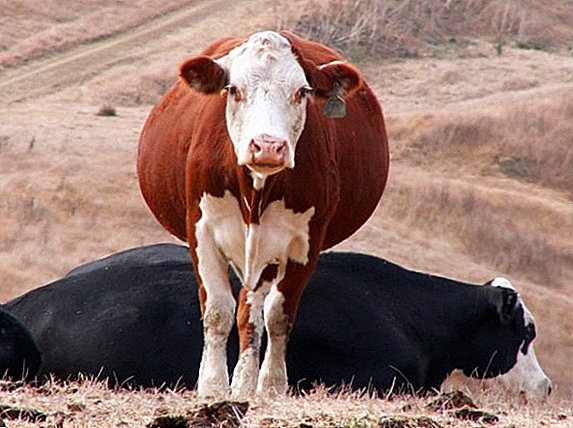
Cockfights are one of the most ancient sports. They attracted many of our ancestors and still remain relevant in almost all countries of the world.
However, the cockfight originated in Asia, where, for the first time, fans of this sport were able to bring out the Sundanesian fighting chickens.
For the first time, this breed of chickens was obtained in Indonesia, where for many years cockfighting remained the only gambling sport.
Breeders sought to get a very active and hardy bird that could fight with any rivals.
Modern Sundanese hens are actively bred in Germany, where they first came to be in the 1970s. They have become stronger and unpretentious in content, which allows them to be used for modern bird fights.
Breed description of the Sundanesian chickens
 The Sundanesian fighting hens have a long body and straight posture. To the tail, it narrows slightly.
The Sundanesian fighting hens have a long body and straight posture. To the tail, it narrows slightly.
On the body there is a long neck with a slight bend. There is a magnificent plumage on the neck, but it does not touch the surface of the shoulders. The head is small, elongated. On the face clearly visible large brow arc.
The back of the fighting chickens is wide and flat. To the rear of the bird, it narrows significantly. The shoulders on the back are wide, sit high and slightly bulged. The wings of the hens are strong and large, so they go back.
The tail of the Sundanesian chickens kept exceptionally horizontal. The braids are of medium length. The chest is not very wide, so it slightly moves forward. The stomach is not strongly protruding. It is almost completely missing plumage.
On the small head, the bird has a noticeably smooth red face. The comb of cocks and hens is very small, has the shape of a pod. However, it is not very rough, has a red color.
Earrings or very small, or completely absent. However, the earring on the throat is clearly visible. The earlobes are red, small. The eyes of the Sundanesian chickens may be orange or light pearl. The beak is small but strong. It is slightly curved at the edge.
 If you are breeding chickens for the sake of eggs, then you must have heard about Loman Brown hens.
If you are breeding chickens for the sake of eggs, then you must have heard about Loman Brown hens.The ankles are of medium length, very muscular. Legs of the same length, wide apart, with spurs pointing backwards. Fingers strongly splayed to maintain balance.
Chickens completely repeat the appearance of roosters, with the exception of basic sexual characteristics. In both sexes there is no down on the shoulders and chest, the back of the bird also has no feathers.
Color can be wheat or black. At the same time, birds with a large number of red or white feathers around their necks are not allowed to the exhibitions.
Features
 Fighting Sundanesian chickens are very aggressive birds. They have a very strong beak, large spurs and massive claws, capable of delivering crushing blows to opponents.
Fighting Sundanesian chickens are very aggressive birds. They have a very strong beak, large spurs and massive claws, capable of delivering crushing blows to opponents.
These birds are characterized by a nervous character, so they are best kept separately from other birds. Also, do not put cocks and chickens together, as the livestock may suffer from constant clashes with each other.
There are also some problems associated with breeding poultry. This breed has almost no maternal instinct.therefore, the hens cannot properly incubate the eggs.
For these purposes it is better to use an incubator. The situation with the breeding of birds is aggravated by the fact that chickens and roosters often fight with each other.
Sundanezian warrior chickens should be started only by those people who are true lovers of these birds. They are not very simple in content, therefore they are suitable only for professionals.
Content and breeding
 The content is fraught with difficulty. Immediately it should be said that fighting chickens can not carry a large number of eggs. Layers are able to lay a maximum of 60 eggs in the first year of their productivity.
The content is fraught with difficulty. Immediately it should be said that fighting chickens can not carry a large number of eggs. Layers are able to lay a maximum of 60 eggs in the first year of their productivity.
In the following years, the level of egg production falls by half, so the bird must be constantly raised. In addition, there is a problem with the fertilization of eggs. Almost half of them may be with underdeveloped embryos or without them at all.
The unpleasant character of these birds does not allow breeders to keep them in a common house.. If other birds live on the plot, the fighting chickens should be separated from them.
It is advisable to settle them in a spacious aviary with a small yard for walking. In no case should we forget about the green yard, since this breed of birds in its homeland used to walk on the green veil.
Juveniles grow very slowly. It reaches sexual maturity only in the second year of life, therefore younger birds are not allowed to exhibit. Youngsters can also be used to participate in battles, however, it is unlikely to be able to do anything against adult and hardy chickens.
Specifications
Sundanese fighter chickens are able to gain weight up to 3 kg. And hens from roosters are only half a kilo behind. The average egg productivity is 60 eggs per year. However, it subsequently decreases significantly, which brings new difficulties for breeders.
For incubation allowed eggs with a weight of at least 45 g
Analogs
 An analogue can be considered fighting chickens breed Azil. This breed is one of the oldest in the world.
An analogue can be considered fighting chickens breed Azil. This breed is one of the oldest in the world.
Her breeding engaged Indians fond of cockfighting. Over several millennia of breeding, they managed to breed a breed with persistent traits.
It is characterized by remarkable endurance, good health and extremely aggressive disposition. Many private poultry farms are breeding this breed, so it is very easy to buy this breed.
Lovers of rarer fighting breeds are well suited Yamato chickens. They are small in size, but it does not prevent these birds from winning even the strongest rivals.
Due to their stamina, they can defeat other, more massive, fighting fighting chickens.
Conclusion
Sundanese fighter chickens are strong and aggressive birds. They feel great in a fight with any opponent, but before the fight starts, the breeder must carefully prepare the bird for training. Without them and without proper nutrition, no fighting bird will be able to win in battle.












